Java8之后,HashMap链表插入方式,为何要从头插入改为尾插入
1.7 的底层数据结构
/**
* An empty table instance to share when the table is not inflated.
*/
static final Entry<?,?>[] EMPTY_TABLE = {};
/**
* The table, resized as necessary. Length MUST Always be a power of two.
*/
transient Entry<K,V>[] table = (Entry<K,V>[]) EMPTY_TABLE;
static class Entry<K,V> implements Map.Entry<K,V> {
final K key;
V value;
Entry<K,V> next;
int hash;
...
}
1.8 的底层数据结构
/**
* The table, initialized on first use, and resized as
* necessary. When allocated, length is always a power of two.
* (We also tolerate length zero in some operations to allow
* bootstrapping mechanics that are currently not needed.)
*/
transient Node<K,V>[] table;
static class Node<K,V> implements Map.Entry<K,V> {
final int hash;
final K key;
V value;
Node<K,V> next;
...
}
/**
* Entry for Tree bins. Extends LinkedHashMap.Entry (which in turn
* extends Node) so can be used as extension of either regular or
* linked node.
*/
static final class TreeNode<K,V> extends LinkedHashMap.Entry<K,V> {
TreeNode<K,V> parent; // red-black tree links
TreeNode<K,V> left;
TreeNode<K,V> right;
TreeNode<K,V> prev; // needed to unlink next upon deletion
boolean red;
...
}
但基础结构还是: 数组 + 链表 ,称作 哈希表 或 散列表
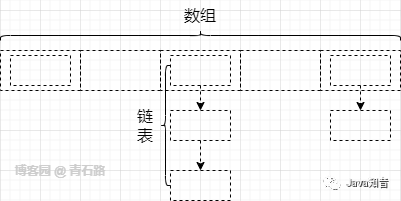
只是 1.8 做了优化,引进了 红黑树 ,来提升链表中元素获取的速度
JDK1.7 头插
只有元素添加的时候,才会出现链表元素的插入,那么我们先来看看 put 方法
put - 添加元素
源码如下
/**
* Associates the specified value with the specified key in this map.
* If the map previously contained a mapping for the key, the old
* value is replaced.
*
* @param key key with which the specified value is to be associated
* @param value value to be associated with the specified key
* @return the previous value associated with <tt>key</tt>, or
* <tt>null</tt> if there was no mapping for <tt>key</tt>.
* (A <tt>null</tt> return can also indicate that the map
* previously associated <tt>null</tt> with <tt>key</tt>.)
*/
public V put(K key, V value) {
if (table == EMPTY_TABLE) {
inflateTable(threshold);
}
if (key == null)
return putForNullKey(value);
int hash = hash(key);
int i = indexFor(hash, table.length);
for (Entry<K,V> e = table[i]; e != null; e = e.next) {
Object k;
if (e.hash == hash && ((k = e.key) == key || key.equals(k))) {
V oldValue = e.value;
e.value = value;
e.recordAccess(this);
return oldValue;
}
}
modCount++;
addEntry(hash, key, value, i);
return null;
}
直接看代码可能不够直观,我们结合流程图来看
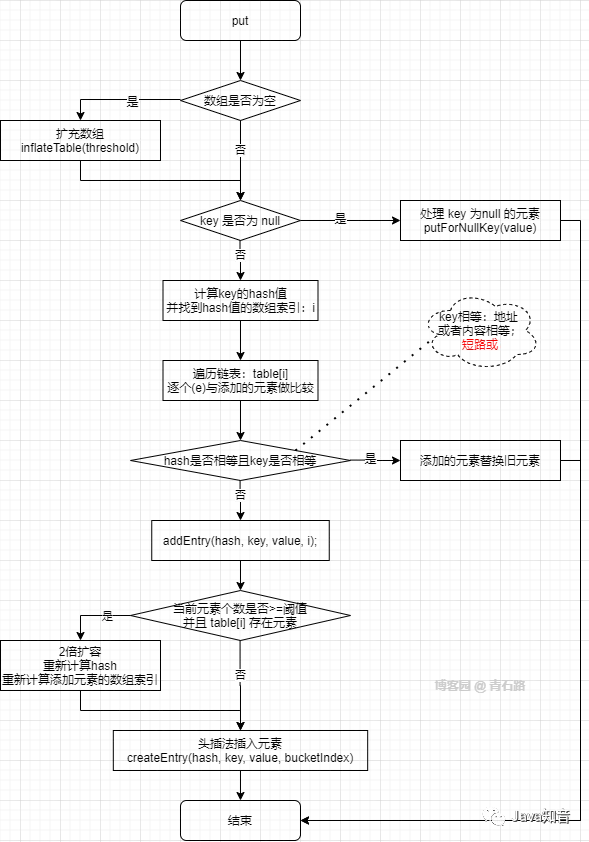
什么?还是不够直观?(楼主也这么觉得)

那我们就结合具体案例来看下这个流程
假设 HashMap 初始状态
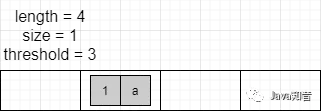
然后依次往里面添加元素:(2,b), (3,w), (5,e), (9,t), (16,p)

再利用断点调试,我们来看看真实情况
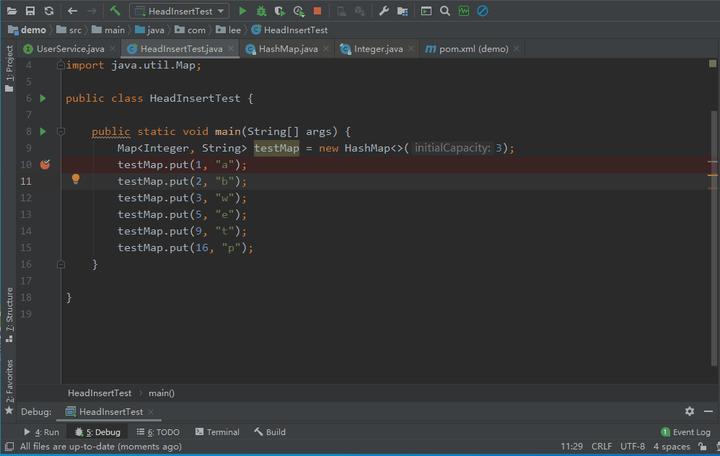
一切都对得上,进展的也挺顺利
resize - 数组扩容
上述提到了扩容,但是没细讲,我们来看看扩容的实现
关键代码如下
/**
* Rehashes the contents of this map into a new array with a
* larger capacity. This method is called automatically when the
* number of keys in this map reaches its threshold.
*
* If current capacity is MAXIMUM_CAPACITY, this method does not
* resize the map, but sets threshold to Integer.MAX_VALUE.
* This has the effect of preventing future calls.
*
* @param newCapacity the new capacity, MUST be a power of two;
* must be greater than current capacity unless current
* capacity is MAXIMUM_CAPACITY (in which case value
* is irrelevant).
*/
void resize(int newCapacity) {
Entry[] oldTable = table;
int oldCapacity = oldTable.length;
if (oldCapacity == MAXIMUM_CAPACITY) {
threshold = Integer.MAX_VALUE;
return;
}
Entry[] newTable = new Entry[newCapacity];
transfer(newTable, initHashSeedAsNeeded(newCapacity));
table = newTable;
threshold = (int)Math.min(newCapacity * loadFactor, MAXIMUM_CAPACITY + 1);
}
/**
* Transfers all entries from current table to newTable.
*/
void transfer(Entry[] newTable, boolean rehash) {
int newCapacity = newTable.length;
for (Entry<K,V> e : table) {
while(null != e) {
Entry<K,V> next = e.next;
if (rehash) {
e.hash = null == e.key ? 0 : hash(e.key);
}
int i = indexFor(e.hash, newCapacity);
e.next = newTable[i];
newTable[i] = e;
e = next;
}
}
}
主要做了两件事:1、创建一个新的 Entry 空数组,长度是原数组的 2 倍,2、遍历原数组,对每个元素重新计算新数组的索引值,然后放入到新数组的对应位置
有意思的是这个转移方法:transfer,我们结合案例来仔细看看
假设扩容之前的状态如下图所示
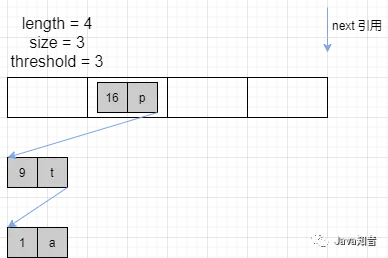
扩容过程如下
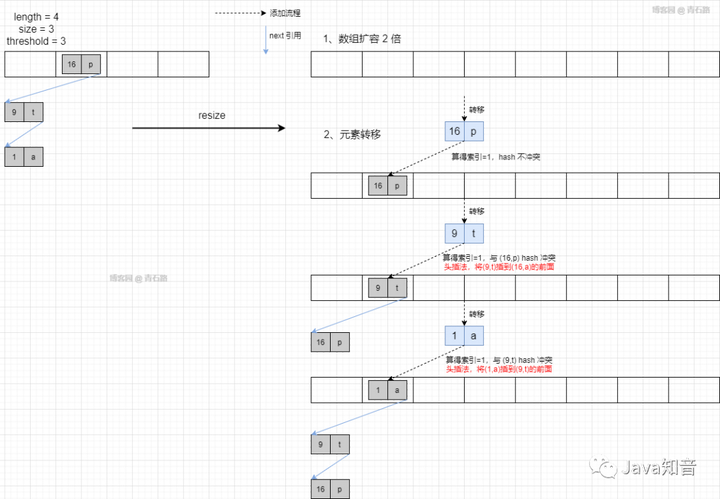
利用断点调试,我们来看看真实情况
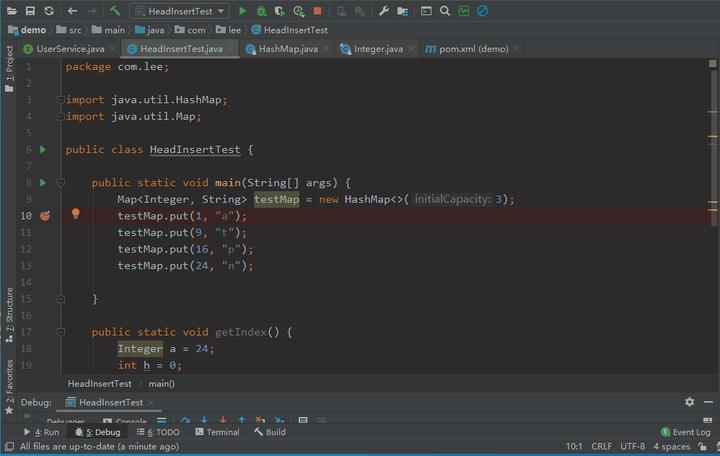
链表元素的转移,还是采用的头插法
链表成环
不管是元素的添加,还是数组扩容,只要涉及到 hash 冲突,就会采用头插法将元素添加到链表中
上面讲了那么多,看似风平浪静,实则暗流涌动;单线程下,确实不会有什么问题,那多线程下呢 ?我们接着往下看
将设扩容之前的的状态如下所示
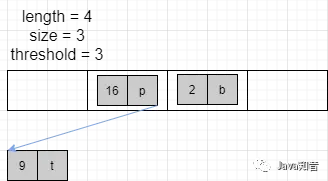
然后,线程 1 添加 (1,a) ,线程 2 添加 (19,n),线程 1 会进行扩容,线程 2 也进行扩容,那么 transfer 的时候就可能出现如下情况
哦豁,链表成环了,这就会导致:Infinite Loop
JDK1.8 尾插
1.8就不讲那么详细了,我们主要来看看 resize 中的元素转移部分
if (oldTab != null) {
// 从索引 0 开始逐个遍历旧 table
for (int j = 0; j < oldCap; ++j) {
Node<K,V> e;
if ((e = oldTab[j]) != null) {
oldTab[j] = null;
if (e.next == null) // 链表只有一个元素
newTab[e.hash & (newCap - 1)] = e;
else if (e instanceof TreeNode) // 红黑树,先不管
((TreeNode<K,V>)e).split(this, newTab, j, oldCap);
else { // preserve order
// 拆链表,拆成两个子链表:索引不变的元素链表和有相同偏移量的元素链表
// 每个链表都保持原有顺序
Node<K,V> loHead = null, loTail = null;
Node<K,V> hiHead = null, hiTail = null;
Node<K,V> next;
do {
next = e.next;
if ((e.hash & oldCap) == 0) {
// 索引不变的元素链表
if (loTail == null)
loHead = e;
else // 通过尾部去关联 next,维持了元素原有顺序
loTail.next = e;
loTail = e;
}
else {
// 相同偏移量的元素链表
if (hiTail == null)
hiHead = e;
else // 通过尾部去关联 next,维持了元素原有顺序
hiTail.next = e;
hiTail = e;
}
} while ((e = next) != null);
if (loTail != null) {
loTail.next = null;
newTab[j] = loHead;
}
if (hiTail != null) {
hiTail.next = null;
newTab[j + oldCap] = hiHead;
}
}
}
}
}
通过尾插法,维护了链表元素的原有顺序
在扩容时,头插法会改变链表中元素原本的顺序,以至于在并发场景下导致链表成环的问题,而尾插法,在扩容时会保持链表元素原本的顺序,就不会出现链表成环的问题
相关疑惑
1、JDK 1.7及之前,为什么采用头插法
呃... 这个可能需要问头插法的实现者了;
但有种说法,我觉得挺有道理:缓存的时间局部性原则,最近访问过的数据下次大概率会再次访问,把刚访问过的元素放在链表最前面可以直接被查询到,减少查找次数
2、既然头插法有链表成环的问题,为什么直到 1.8 才采用尾插法来替代头插法
只有在并发情况下,头插法才会出现链表成环的问题,多线程情况下,HashMap 本就非线程安全,这就相当于你在它的规则之外出了问题,那能怪谁?
1.8 采用尾插,是对 1.7 的优化
3、既然 1.8 没有链表成环的问题,那是不是说明可以把 1.8 中的 HashMap 用在多线程中
链表成环只是并发问题中的一种,1.8 虽然解决了此问题,但是还是会有很多其他的并发问题,比如:上秒 put 的值,下秒 get 的时候却不是刚 put 的值;因为操作都没有加锁,不是线程安全的
总结
1、JDK 1.7 采用头插法来添加链表元素,存在链表成环的问题,1.8 中做了优化,采用尾插法来添加链表元素
2、HashMap 不管在哪个版本都不是线程安全的,出了并发问题不要怪 HashMap,从自己身上找原因
如果您发现该资源为电子书等存在侵权的资源或对该资源描述不正确等,可点击“私信”按钮向作者进行反馈;如作者无回复可进行平台仲裁,我们会在第一时间进行处理!
- 最近热门资源
- 银河麒麟桌面操作系统备份用户数据 123
- 统信桌面专业版【全盘安装UOS系统】介绍 116
- 银河麒麟桌面操作系统安装佳能打印机驱动方法 108
- 银河麒麟桌面操作系统 V10-SP1用户密码修改 101









